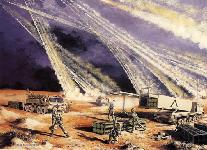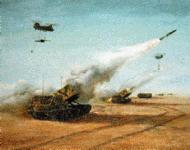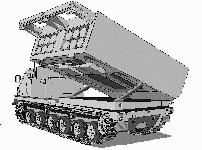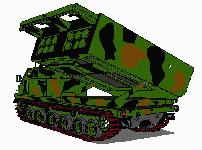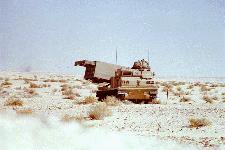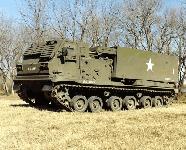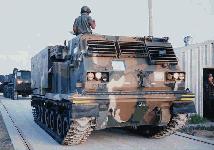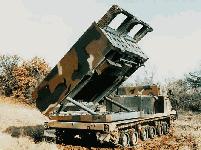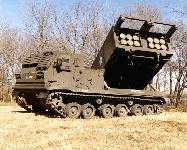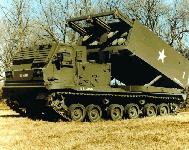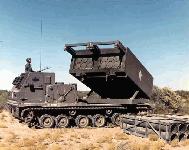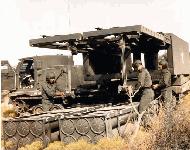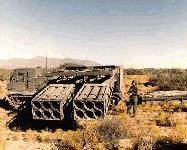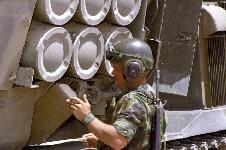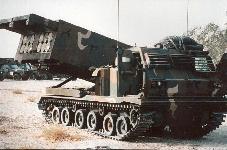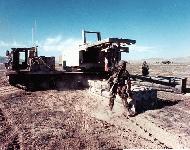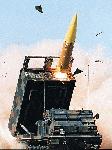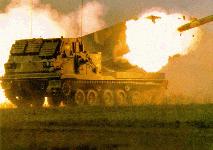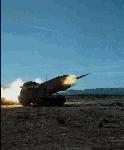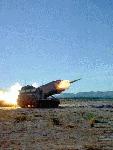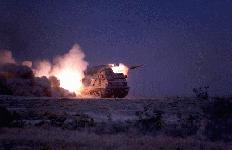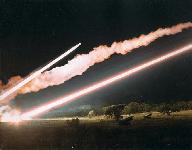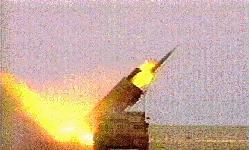 The Multiple Launch Rocket System (MLRS) provides the Army an all-weather, indirect, area fire weapon system to strike
counterfire, air defense, armored formations, and other high-payoff targets at all depths of the tactical battlefield. Primary
missions of MLRS include the suppression, neutralization and destruction of threat fire support and forward area air defense
targets.
The Multiple Launch Rocket System is a versatile weapon system that supplements
traditional cannon artillery fires by delivering large volumes of firepower in a short time against
critical, time-sensitive targets. These targets often include enemy artillery, air defense systems,
mechanized units, and personnel. MLRS units can use their system's "shoot and scoot" capability to
survive while providing fire support for attacking manuever elements. MLRS is not intended to
replace cannon artillery, but has been designed to complement it.
MLRS performed extremely well in Operation Desert Storm (ODS) in which significant numbers of
launchers were deployed. All operational requirement were met and, in most cases, exceeded levels for readiness, reliability and maintainability. MLRS units from the United Kingdom were also involved in ODS and proved the value of this multi-national system. The new upgrade MLRS (Deep Attack Launcher) also demonstrated its enormous capability during the first operational firings of the longer range ATACMS.
The Army has initiated an extensive improvements program to enhance MLRS's basic capability. The improvements are in three areas--an extended range rocket (from 32 kilometers to 50 kilometers), an improved fire control system, and an improved launcher mechanical system. The extended range rocket has a reduced payload of M77 submunitions and a longer rocket motor to enable attainment of the additional 18 kilometers of flight. The improved fire control system includes a meteorological sensor, a positioning navigation unit combined with global positioning system and a new launcher interface unit with increased throughput capacities in the main and communication processors. The improved launcher mechanical systems consists of non-developmental item improvements to the elevation transmission, elevation motor, azimuth motor and motor control.
The Multiple Launch Rocket System (MLRS) provides the Army an all-weather, indirect, area fire weapon system to strike
counterfire, air defense, armored formations, and other high-payoff targets at all depths of the tactical battlefield. Primary
missions of MLRS include the suppression, neutralization and destruction of threat fire support and forward area air defense
targets.
The Multiple Launch Rocket System is a versatile weapon system that supplements
traditional cannon artillery fires by delivering large volumes of firepower in a short time against
critical, time-sensitive targets. These targets often include enemy artillery, air defense systems,
mechanized units, and personnel. MLRS units can use their system's "shoot and scoot" capability to
survive while providing fire support for attacking manuever elements. MLRS is not intended to
replace cannon artillery, but has been designed to complement it.
MLRS performed extremely well in Operation Desert Storm (ODS) in which significant numbers of
launchers were deployed. All operational requirement were met and, in most cases, exceeded levels for readiness, reliability and maintainability. MLRS units from the United Kingdom were also involved in ODS and proved the value of this multi-national system. The new upgrade MLRS (Deep Attack Launcher) also demonstrated its enormous capability during the first operational firings of the longer range ATACMS.
The Army has initiated an extensive improvements program to enhance MLRS's basic capability. The improvements are in three areas--an extended range rocket (from 32 kilometers to 50 kilometers), an improved fire control system, and an improved launcher mechanical system. The extended range rocket has a reduced payload of M77 submunitions and a longer rocket motor to enable attainment of the additional 18 kilometers of flight. The improved fire control system includes a meteorological sensor, a positioning navigation unit combined with global positioning system and a new launcher interface unit with increased throughput capacities in the main and communication processors. The improved launcher mechanical systems consists of non-developmental item improvements to the elevation transmission, elevation motor, azimuth motor and motor control.
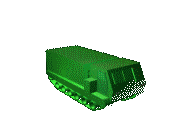 The MLRS M270 Launcher, a derivative of the Bradley Fighting Vehicle (BFV), is the standard U.S. Army platform for firing surface to surface artillery rockets and missiles.
The Armored Vehicle Mounted Rocket Launcher (M270) is a full-tracked,
self-propelled launcher/loader designed to launch 12 tactical
rockets and re-deploy before enemy determination of launch position
(shoot and scoot). The launch platform is also used to launch
the Army Tactical Missile System (Army TACMS) and is capable of
launching all M270 Family of Munitions (MFOM) tactical rocket/missile
variants. The launcher consists of six rockets, each of which
are mounted and controlled in both azimuth and elevation. It has
an automated control system for aiming that automatically corrects
for launcher cant and ambient temperature, a directional reference
system to obtain azimuth elevation and cant angles, and a FCS
which is operated from a man-rated vehicle cab. The launcher platform
structure provides a "self-loading" capability.
The M270 launcher has a maximum speed of 64 Km/hour, with a maximum
range of 435 Km. It is capable of climbing a 60 degree slope and
a one meter wall. Ordnance options include the MFOM (all variants
of the MLRS rocket and Army TACMS missile). The M270 can load,
arm, and fire a 12 rocket ripple within ripple within five minutes.
M270 launchers are deployed three per battery and 29 per battalion.
The M270 launcher can be configured for transport by Air Force
C-141 aircraft on a limited basis. The M270 launcher is also transportable
by Air Force C-5 and C-17 aircraft.
MLRS consists of a self-loading launcher with an onboard fire control system (FCS). The launcher is mounted on a mobile
track vehicle that carries 12 rockets or 2 Army Tactical Missile System (Army TACMS) missiles, which can be fired
individually or simultaneously. Rockets have a range beyond 30 kilometers, and the Army TACMS Block IA missile can reach
to 300 kilometers.
The MLRS M270 Launcher, a derivative of the Bradley Fighting Vehicle (BFV), is the standard U.S. Army platform for firing surface to surface artillery rockets and missiles.
The Armored Vehicle Mounted Rocket Launcher (M270) is a full-tracked,
self-propelled launcher/loader designed to launch 12 tactical
rockets and re-deploy before enemy determination of launch position
(shoot and scoot). The launch platform is also used to launch
the Army Tactical Missile System (Army TACMS) and is capable of
launching all M270 Family of Munitions (MFOM) tactical rocket/missile
variants. The launcher consists of six rockets, each of which
are mounted and controlled in both azimuth and elevation. It has
an automated control system for aiming that automatically corrects
for launcher cant and ambient temperature, a directional reference
system to obtain azimuth elevation and cant angles, and a FCS
which is operated from a man-rated vehicle cab. The launcher platform
structure provides a "self-loading" capability.
The M270 launcher has a maximum speed of 64 Km/hour, with a maximum
range of 435 Km. It is capable of climbing a 60 degree slope and
a one meter wall. Ordnance options include the MFOM (all variants
of the MLRS rocket and Army TACMS missile). The M270 can load,
arm, and fire a 12 rocket ripple within ripple within five minutes.
M270 launchers are deployed three per battery and 29 per battalion.
The M270 launcher can be configured for transport by Air Force
C-141 aircraft on a limited basis. The M270 launcher is also transportable
by Air Force C-5 and C-17 aircraft.
MLRS consists of a self-loading launcher with an onboard fire control system (FCS). The launcher is mounted on a mobile
track vehicle that carries 12 rockets or 2 Army Tactical Missile System (Army TACMS) missiles, which can be fired
individually or simultaneously. Rockets have a range beyond 30 kilometers, and the Army TACMS Block IA missile can reach
to 300 kilometers.
The M270 MLRS, or SPLL (Self-Propelled, Loader/Launcher), is made up of two major units and an electronic fire control system (FCS). The SPLL is a mobile, self-propelled, self- loading, multiple launch rocket firing unit. It provides mobile long range artillery rocket support for ground forces. The M993 Carrier Vehicle and the M269 LLM are the two major units that make up the MLRS. The FCS is a computer control system, with a built-in computer and memory system. The SPLL has a cruising range of 300 miles at speeds up to 40 miles per hour. The total MLRS weights approximately 52,990 pounds.
The second multiyear procurement contract for FY89-93 was awarded in July 1989 for MLRS. The US initial operational capability for MLRS was achieved in 1983. Starting in FY89, MLRS has been coproduced by the United States, United Kingdom, Germany, France, and Italy. As of September 1995, a total of 857 launchers have been delivered, 772 to the active Army and 185 to the National Guard.Upgrades
The MLRS M270 launcher is being upgraded to accommodate a new MLRS family of munitions (MFOM), including the Army Tactical Missile System. The improvements provided by the M270A1 will enhance the field artillery's support to armor and infantry units to reinforce the dominant maneuver force by improving the corps commander's precision engagement capabilities for shaping the battlespace at extended ranges. The MLRS M270A1 program is on schedule to be fielded in September 2000.- 1QFY98 IFCS Low Rate Initial Production (LRIP) Decision
- 2QFY99 Combined IFCS/ILMS operational test
- 3QFY00 First unit equipped M270A1
- 2QFY98 - First Extended Range Rocket MLRS rocket delivery
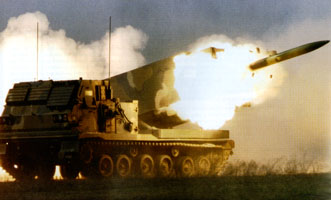 The Improved Fire Control System
(IFCS) replaces obsolete, maintenance-intensive hardware and software, providing growth potential for future
munitions and the potential for reduced launcher operation and support costs. A Global Positioning System-aided navigation
system for the launcher is being developed as part of IFCS to supplement the existing inertial position-navigation system. The
IFCS modification will upgrade the electronic and navigation equipment, revise the software architecture, and add the
capability of sensing local meteorological conditions at 100 meters above ground level. This latter capability is intended to
improve rocket accuracy by providing current, low-level wind measurements to the launcher just before launch.
The Improved Launcher Mechanical System (ILMS) is designed to decrease the time required to aim and load the
launcher. This is achieved by providing a faster launcher drive system that moves simultaneously in azimuth and elevation.
ILMS is expected to reduce the traverse time from the stowed position to worst case aimpoint by approximately 80 percent. It
will also decrease the mechanical system contribution to reload time by about 40 percent. The reduction in time spent at the
launch and reload points is intended to increase survivability.
In addition to the IFCS and ILMS modifications, the M270A1 program includes the remanufacture of selected components
and the application of selected Engineering Change Proposals to the basic M270 launcher to bring all launchers to the same
configuration.
The Improved Fire Control System
(IFCS) replaces obsolete, maintenance-intensive hardware and software, providing growth potential for future
munitions and the potential for reduced launcher operation and support costs. A Global Positioning System-aided navigation
system for the launcher is being developed as part of IFCS to supplement the existing inertial position-navigation system. The
IFCS modification will upgrade the electronic and navigation equipment, revise the software architecture, and add the
capability of sensing local meteorological conditions at 100 meters above ground level. This latter capability is intended to
improve rocket accuracy by providing current, low-level wind measurements to the launcher just before launch.
The Improved Launcher Mechanical System (ILMS) is designed to decrease the time required to aim and load the
launcher. This is achieved by providing a faster launcher drive system that moves simultaneously in azimuth and elevation.
ILMS is expected to reduce the traverse time from the stowed position to worst case aimpoint by approximately 80 percent. It
will also decrease the mechanical system contribution to reload time by about 40 percent. The reduction in time spent at the
launch and reload points is intended to increase survivability.
In addition to the IFCS and ILMS modifications, the M270A1 program includes the remanufacture of selected components
and the application of selected Engineering Change Proposals to the basic M270 launcher to bring all launchers to the same
configuration.
An M270A1 System Integration Update briefing was presented to COL (P) Holly, the Program Executive Officer (PEO), Tactical Missiles on 26 April 99. This briefing addressed the status of Improved Launcher Mechanical System (ILMS) qualification testing, and system level testing to date. The M270A1 Acquisition Strategy is a three-phase strategy with Phases I & II completed and is on track to meet the Phase III which is the Milestone III Full Rate Production Decision in FY 00. The Phase III decision authority has been delegated to the COL (P) Holly by the Army Acquisition Decision Authority.
The M270A1 Logistics Demonstration (Log Demo) began 25 Oct 98 and was completed on 15 Jan 99 successfully accomplishing 239 maintenance tasks, 10 of these tasks were performed in MOPP IV. Soldiers from Ft. Sill, OK (13M-operator and 27M-maintainer) participated in the Logistics Demonstration. The soldiers had no problems using the M270A1 Interactive Electronic Technical Manual (IETM) or the SPORT lightweight computer. The outcome of this extensive Logistics Demonstration indicates the M270A1 is supportable by the soldier in the field today.
The M270A1 began the Developmental Test/Operational Test (DT/OT) flight phase of the Operational Test (OT) in Apr 99. The DT/OT flight phase tests have included the successful firings of MLRS M26, M28 rockets, and Army Tactical Missile System (ATACMS) Block I and IA missions at White Sands Missile Range. Future planned flight test firings include Development Test firings of MLRS Guided Rocket (FY 00).
Deployment
In September 1997 the first US Army Command & Attack Battalion (CAB) Field Artillery (FA) unit was activated. This program previously known as the MLRS "2x9" fielded another MLRS firing battery and a Headquarters, Headquarters & Service (HHS) battery to the Division Artillery of the 1st Cavalry Division at Fort Hood, TX. This change merged these new batteries with the existing MLRS Battery, A Btry, 21st FA and the Target Acquisition Battery (TAB), B Battery, 26th FA. The new unit is now known as 1st Bn, 21st FA (1-21 FA).
This program will not be unique to 1st Cavalry Division. Over the upcoming years, fieldings will take place to all of the current "heavy" divisions within the active army. The direction to make this change was as a result of a decision made by the Vice-Chief of Staff of the Army on 29 Feb 96. The decision for this plan was put forward based on the Nov 93 release of the Legal Mix V Study with subsequent conclusions from the Army Science Board in Oct 95. The rationale was based on analysis that indicated the need for additional firepower within the division.
The next unit to be changed wwas the conversion of B Btry, 20th FA (MLRS) and A Btry, 26th FA (TAB) to 2-20 FA at 4th Mechanized Infantry Division, Fort Hood, TX in Jul 98. In 4QFY99, A Btry, 13th FA (MLRS) and A Btry, 39th FA (TAB) will convert to 1-39 FA at Fort Stewart, GA. After FY99 the remaining three (3) CAB fieldings are planned to be fielded with the M270A1 Launchers. These systems will be remanufactured launchers that will include the Improved Fire Control System (IFCS) and Improved Launcher Mechanical System (ILMS). These units are A Btry, 38th FA (MLRS) and F Btry, 26th FA (TAB) to 1-38 FA to be fielded in FY01in Korea; and in Germany the fieldings A Btry, 94th FA (MLRS) and C Btry, 25th FA (TAB) in FY03, and A Btry, 33 FA (TAB) and B Btry 25th FA (TAB) in FY05.
Specifications | |
| 857 systems Army ACAT IC Program | |
| Total program cost (TY$) | $1,969.1M |
| Average unit cost (TY$) | $2.3M |
| Full-rate Production | 4QFY99 |
| Prime Contractor | Lockheed Martin Vought Systems |
| Crew | 3 man |
| Cruise Range | 483 km |
| On Board Fire Control and Position Determining System | |
| 12 Rockets; 644 M-77 Shaped Charges per Rocket | |
| Reload Time | 9 minutes |
| Rocket Range | 31.8 km |
| REFERENCES |
|



